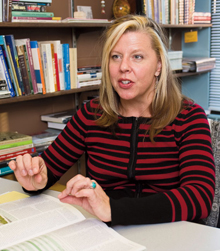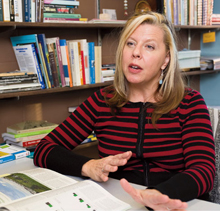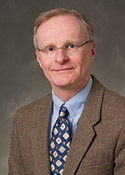Photography by Stan Waldhauser
Brenda Kayzar started her career in real estate lending, working for a bank in Chicago, then later running her own mortgage brokerage in Southern California. Today, she’s an assistant professor of geography at the University of Minnesota with a strong research interest in the suburban system of housing of which she once was a part.
Kayzar sees the current housing slump as an opportunity to reassess the standard pattern of development in outer suburbs—single-family homes built in spread-out neighborhoods accessible only by car. In 2008 and 2009, she and fellow researchers at the university undertook a “community growth options toolkit” project in the Twin Cities outer suburbs of Farmington and Rosemount to help civic leaders and residents envision an alternative approach to development on the periphery of metro areas.
Recently, she spoke to the fedgazette about the prospects for change in exurbia.
fedgazette: The housing market in many metro areas in the Ninth District remains in the doldrums. If we want to rethink the standard low-density, dispersed model for exurban development, why is this a good time to do that?

Brenda Kayzar
Kayzar: In a heated market, when there’s a big rush of development going on and you have big demand for housing, there’s no changing the 20-year comprehensive plan at that point. You’re going to do it the easiest way possible, because the zoning’s already in place. In a hot market, people are not going to buck the system and say, “We’re going to rethink this, we want to do some different densities, different types of housing, some mixed residential and commercial uses.” But when the market slows and there’s less demand for housing in the periphery, I think that’s a good time to say, “Let’s think about this before the next boom comes along and we’re working with this long-term plan that doesn’t have a real vision.”
fedgazette: Why should we rethink development patterns on the city-rural fringe at all? Doesn’t rapid residential growth in these areas over the past 20 to 30 years show that the current model of low-density development works—that this is what home buyers want?
Kayzar: Well, the assumption that’s made there is that buyers are demanding this—that supply is really meeting demand. But if we look at our inventory of housing in this country, the majority of it is suburban-style, single-family houses. So when you ask people to describe their ideal home, their reply is going to be in many ways shaped by the fact that they don’t have any other experiences to compare it with. To try to envision another experience—how would they do that when the majority of housing that’s out there is this model?
There’s also the issue of cost and lack of affordability. We’re moving that front edge of suburbia farther and farther out into these peripheral communities, and we’re building based on a model that’s very expensive to purchase and maintain. Low density, the idea of the countryside and not having your neighbors close by—all of that argues for a large lot, a large-footprint home. Infrastructure is expensive to build out in the periphery; you’re covering a lot more ground with plumbing hookups, water lines, etc., and instead of tapping into existing structures, you’re creating wholly new structures.
fedgazette: All of that may be true, but after previous housing busts, the housing market on the edge of metro areas rebounded, with robust growth continuing as before. Why shouldn’t we expect history to repeat itself?
Kayzar: That expectation does not really take into consideration the fact that our household structure has changed so much, especially within the last decade. We’re looking at a model for development that was created for one type of household—the nuclear family—which makes up less than 25 percent of [U.S.] households today. Yet we have many single-parent households; we have many no-children households; we have this huge, huge growing demographic of aging baby boomers. Municipalities are going to have to look at how to provide all the services that an aging population is going to need. They’re aging in place; they might not be able to drive; they may not get to the types of services they want in a suburban setting.
fedgazette: Briefly describe your “community growth options toolkit” project in Rosemount and Farmington—what did you set out to accomplish in these Twin Cities exurbs?
Kayzar: These two communities had developed new 2030 comprehensive plans that were in the process of being approved by the city council and the community. The plans were set in place when the market was still booming, so they maintained a lot of the same ideals that the previous plans did—single-family homes, low density, etc. For the most part, it was business as usual. In interviews, the lead planners for Rosemount and Farmington had outlined their concerns: demographic shifts, not being able to get young people to move back to the community after they left to go to college.
The idea behind the toolkit was to gain some capacity for doing something different in a changing market. First, we used mapping as a way to represent potential change—what would alternatives to the current model look like? Second, we suggested ways to educate the public about development options, to reduce apprehension about developing in a different way.
fedgazette: Did your mapping propose zoning changes to reshape these communities?
Kayzar: [Nods] We developed three different scenarios that involved either changing zoning to permit higher-density development in some areas or simply going to the maximum density allowed under current zoning. By overlaying these scenarios on a map, we can show how a community can create a greater diversity of housing types and sizes in order to attract buyers. Maybe someone in Rosemount has grown children who went away to college, but now they’re working and they’re thinking about where they want to live. Well, now they can come back to Rosemount because they can afford a 1,000- or 800-square-foot place. Maybe a young family can have their aging parents living in an accessory dwelling unit—a small house in the back of the main house.
What we tried to show in the maps is that if you do this, not only do you get the benefit of having housing that meets a greater demand; in addition, you don’t have the costs of sprawling infrastructure, the costs of lost agricultural land and open space. These are all things that should make a difference to the municipality in the future.
fedgazette: Why the need for such a planning toolkit? If home buyers in the exurbs are gravitating toward this denser and more diverse model of development, why can’t city planners let the market provide it, altering zoning to accommodate it if necessary?
Kayzar: We have all of these structures in place that perpetuate the suburban model of development; going to the alternative is like stopping a freight train. Planners talk about this a lot, the fact that any effort to make changes and talk about increasing density is met with a NIMBY response; the community says, “We really don’t want that in our community.”
This is where the education process comes in. The toolkit gives planners some resources they can use to help all the stakeholders envision affordability and density in a different way. One of the problems is the language [of development]. When you start talking about density in suburban communities, people think in terms of high-rise condo towers. Affordability somehow equates to subsidized housing and poor people and crime. One of the things we try to do is overcome this terminology. For example, you can have market-rate affordability. What does it look like? Well, it means homes with a smaller footprint, or townhouses or row homes instead of single-family homes.
None of these suggestions for changes in density is going to create anything remotely urban in peripheral communities. It’s still going to look like a suburb. What you have to do is get people over the terms, over the preconceptions, to get them to envision what a little bit different suburb could look like.
fedgazette: You’ve said that another obstacle to breaking the suburban mold is reluctance by lenders to finance nonstandard housing. Why is that? Again, if people wanted townhouses and other types of compact development, why wouldn’t banks and other investors finance it?
Kayzar: You’re asking lenders and insurers to change their concept of housing. Our residential mortgage system grew up in tandem with the post-World War II housing boom; it’s a mass production process. The most standard residential loan, with regard to analysis and administration, is for a single-family home. Nontraditional development means that appraisers and underwriters are going to have to rethink the property. Lenders are now going to have to stop and say, “OK, how can we determine what the value really is, because we haven’t really seen that before, so we don’t know whether that’s going to work or not.”
Also, standard suburban design calls for a separation of uses—commercial from residential—and financing for properties mirrors the segregation of land uses on the ground. When you develop a property with both types of uses—say, condo units with ground-level retail—you’re mixing commercial and residential loans, and that’s seen as higher risk. There’s still limited precedent for mixed-use building loans, so it’s difficult to value these types of property, to find local comparables to do a comprehensive appraisal.
fedgazette: How did planners in Rosemount and Farmington respond to your proposals? Does either city plan to alter its development approach?

Kayzar: The response from each planner differed. The planner in Farmington was very interested in the information provided in our report. She told me she planned to draw from this information when talking to city council members about the need to rethink some of the plans for future growth in her city. She was like, “I need these tools in order to help get across to the city council what I’d like them to do. I need to have them understand.” She views the surrounding agricultural fields as an amenity that makes Farmington unique, so she has a desire to preserve this land. I may do some follow-up work for her, provide some additional visualizations she can use.
The planner in Rosemount was less enthused. He felt we misrepresented his community, that it’s not peripheral, but suburban. Although he indicated in initial conversations that he was concerned about changing demographics, he was adamant that developers would not build higher-density projects or alternative-housing types. He suggested that they knew market demand and would dictate supply. He also suggested that closer-in communities would provide enough higher-density housing, so Rosemount should remain low density to meet demand for that type of housing. He felt the city’s 2030 plan created enough diversity in housing to meet future needs.
fedgazette: If indeed we’re on the cusp of a new paradigm for exurban development, is this break from the past likely to be evolutionary rather than revolutionary? Will change take years or even decades?
Kayzar: One of the telling things will be how much time it takes for these peripheral communities to recover from this particular market downturn. This housing downturn is unlike anything that’s ever happened before. In past downturns, the market has taken five to seven years to really come back in peripheral communities. Well, what if it’s more than a decade? What if this particular housing recovery is something like 15-plus years? Obviously, that’s going to be an impetus for change. That’s why I think it’s a good time to look at it now, to start having this conversation.
The other, long-term factor is the demographic shift—what is going to happen to this huge inventory of single-family homes in peripheral communities as the baby-boom generation ages? Is that huge inventory going to become an albatross? That’s when peripheral communities are going to start saying, “We’re losing population, we need to attract somebody. How do we attract them?” That’s maybe when they would start to think about building in a different way.





